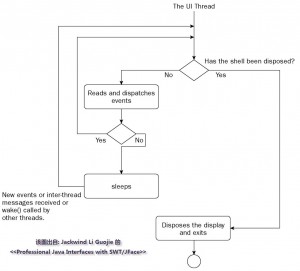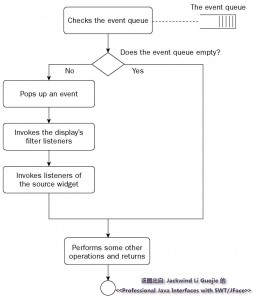Swing中多线程操作UI
Categories: Java; Tagged with: Java • SWT • UI Thread • 多线程; @ February 4th, 2009 0:17通常 Swing 不是线程安全的。除非另行说明,否则所有 Swing 组件及相关类都必须在事件调度线程上访问。
由于Swing不是线程安全的, 因此在实际操作过程中, 应避免通过多线程来操作UI. 在必要时, 应注意要将控件转移到事件调度线程。转移控件和开始处理 Swing 的首选方法是使用 invokeLater。
简单的实践:
在如下小程序中, 通过最上方或最下方的Parse 都可以针对某文件或URL进行解析, 并解析出文件中含有的Email, 并归类但因在中间的TextArea中.
在按下Parse时, 将创建一个新的线程, 进行操作.
onParse: 为每个请求创建新的线程:
/** 响应Parse点击或textFilePath回车 - 为每个请求创建一个单独线程 */
private ActionListener onParse = new ActionListener() {
public void actionPerformed(ActionEvent e){
//通过事件来源来判断读取哪个filePath;
if(e.getSource().equals(buttonParse) || e.getSource().equals(textFilePath)) {
filePathOnAction = textFilePath.getText();
}else if(e.getSource().equals(buttonParse2) || e.getSource().equals(textFilePath2)) {
filePathOnAction = textFilePath2.getText();
}
Thread threadParseEmail = new Thread(){ //将为每个请求创造一个线程
@Override
public void run() {
parseEmail(swui.filePathOnAction);
}
};
threadParseEmail.setName("ParseEmail-" + threadParseEmail.getName());
threadParseEmail.start();
log.debug("Parse clicked"); //使用log, 便于分辨线程
}
};
//解析文件, 将ParseEmail返回信息打印到textOutPut中
private void parseEmail(final String filePath) {
//buttonParse.setEnabled(false);
log.info("正在解析");
labelInfoMessage.setText("正在解析");
if(labelImage.getIcon() == null) {
labelImage.setIcon(imageParseing);
}else {
labelImage.setVisible(true);
}
//TODO Update UI code is put to the AWT-Event Queue so that only the AWT-Event Queue thread executes the UI update code.
// Other threads may update UI directly but problems may arise in many cases.
SwingUtilities.invokeLater(new Runnable() {
@Override
public void run() {
log.info("Update UI code is put to the AWT-Event Queue so that only the AWT-Event Queue thread executes the UI update code");
try {
if(filePath.startsWith("http")) {
URL romatefile = new URL(filePath);
textOutput.setText(pe.parseEmailAndReturnDomain(romatefile.openStream()));
}else {
textOutput.setText(pe.parseEmailAndReturnDomain(filePath));
}
labelInfoMessage.setText("解析完毕");
} catch (Exception e) {
log.debug("IO Exception - File does not exist");
labelInfoMessage.setText("文件不存在, 请确地址是否正确.");
textOutput.setText("文件不存在, 请确地址是否正确.");
}
labelImage.setVisible(false);
}
});
}
log信息:
[AWT-EventQueue-0] DEBUG com.maill.parser.test.UI – Parse clicked //UI线程
[ParseEmail-Thread-2] INFO com.maill.parser.test.UI – 正在解析 //表明已经创建新的线程
[AWT-EventQueue-0] INFO com.maill.parser.test.UI – Update UI code is put to the AWT-Event Queue so that only the AWT-Event Queue thread executes the UI update code //将Thread-2中操作UI的部分交由UI线程处理.
=============================
类似的, 在SWT中, 不允许由非UI线程进行UI操作, 否则将会有Exception抛出. 而在Swing中, 不会抛出任何Exception, 但会产生不安全隐患.
SWT中的event loop flow:
上图中的Read adn dispatch:
StringBuilder 小结
Categories: Java; Tagged with: Java • StringBuilder; @ February 1st, 2009 15:54
//----------------------以下待删除--------------
// TODO 学习后删除;
public static String getTestString() {
StringBuilder sb = new StringBuilder();//新建一个SB
sb.append("Print: ");
for(int i=0; i < 10; i++) {
if(i != 0) {
sb.append(", ");
// s += ", "; //BAD!
}
sb.append(i);
// s += i; //BAD!
}
sb.append("a").append("b").append("C").
append("w");
return sb.toString();
System.out.println(sb.toString());
// return s; // BAD!
// return "Id: " + id; // 简单情况下使用"+"链接, OK
}
Java I/O 操作
Categories: Java February 1st, 2009 15:49处理一个本地文件 或是一个InputStream
public String parseEmail(String fileName) throws IOException{
java.io.File file = new java.io.File(fileName);
if(file.isFile()) {
return parseEmail(new FileInputStream(fileName));
}else {
throw new IOException();
}
}
public String parseEmail(InputStream in) throws IOException{
// InputStream in = new FileInputStream(fileName);
InputStreamReader reader;
reader = new InputStreamReader(in);
BufferedReader br = new BufferedReader(reader);
String data1;
//按行读
while((data1= br.readLine()) != null) {
System.out.println(data1);
}
待续…
Java正则表达式使用笔记
Categories: Java; Tagged with: Java • RegEx; @ February 1st, 2009 15:401. 编写并测试正则表达式.
使用工具:
Eclipse 正则表达式书写测试插件 – 基于java.util.regex
2.
//定义正则表达式
//定义正则表达式
private static final String REGEX_EMAIL = "([\\w\\.-]{1,})@(([\\w-]{1,}\\.)+[a-zA-Z]{2,})"; //Group1, 2;
3. 使用
Pattern patternEmail = Pattern.compile(REGEX_EMAIL);
java.util.regex.Matcher matcherEmail = patternEmail.matcher(data);
while (matcherEmail.find()) {
String pb = matcherEmail.group(1);
String pa = matcherEmail.group(2).toLowerCase();
,............
}
其中data为string类型
该正则表达式将取得data中所有的email地址.
其中group1为@前的字符 group2为@之后的domain.
Java中使用参数选择 – Use Preferences in Java
Categories: Java; Tagged with: Java • Prefereces • 参数选择; @ February 1st, 2009 0:30API: http://gceclub.sun.com.cn/Java_Docs/html/zh_CN/api/java/util/prefs/Preferences.html
需求: 某文件解析器, 设定解析的默认文件, 在关闭时将最后一次解析的路径保存, 再次打开时, 取出上次解析文件之路径.
用法:
取得针对此包的用户和系统参数选择的Preferences对象:
private Preferences userPrefs = Preferences.userNodeForPackage(SwingUI.class);
private Preferences sysPrefs = Preferences.systemNodeForPackage(SwingUI.class);
查询参数选择值[默认值]:
public void initPrefs() {
filePath = userPrefs.get("filePath", http://liguoliang.com/email.txt);
}
关闭之前保存最后一次解析文件的路径:
监听关闭事件:
/**//* 使用匿名类添加一个窗口监听器 */
addWindowListener(new WindowAdapter() {
public void windowClosing(WindowEvent e) {
savePrefs();
System.out.println(
"Exit when Closed event");
//退出应用程序
System.exit(0);
}
});
保存数据
public void savePrefs() {
userPrefs.put("filePath", textFilePath.getText());
try {
userPrefs.flush();
} catch (BackingStoreException e) {
// TODO Auto-generated catch block
e.printStackTrace();
}
}
如图: 第一次运行时, 默认路径: http://liguoliang.com/email.txt
在File中输入: http://xjst.org

点击关闭程序, 再次运行:
此时默认路径为上一次解析的http://xjst.org/




